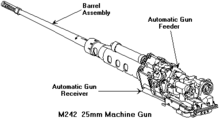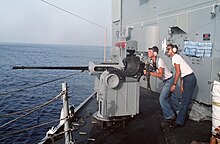| This article's lead section may be too short to adequately summarize the key points. Please consider expanding the lead to provide an accessible overview of all important aspects of the article. (June 2021) |

A chain gun is a type of autocannon or machine gun that uses an external source of power to cycle the weapon's action via a continuous loop of chain, similar to that used on a motorcycle or bicycle, instead of diverting excess energy from the cartridges' propellant as in a typical automatic firearm.
History
In 1972, Hughes Helicopters began a company-funded research effort to design a single machine gun to fire the U.S. Army's M50 20 mm round. In April 1973, the program fired test rounds in more powerful 30 mm WECOM linked ammunition, from a prototype A model. In January 1975, a model "C" was added, a linkless version for the proposed Advanced Attack Helicopter YAH-64. The helicopter was later adopted as the Hughes Model 77/AH-64A Apache, with the model C receiving the designation M230 chain gun as its standard armament.
In 1976, Hughes Helicopters patented the chain gun, and it has since been further developed into several other systems of different calibers.

As of 2019, "chain gun" is a registered trademark of Northrop Grumman Innovation Systems, formerly Orbital ATK, following several mergers and acquisitions after Hughes Helicopters, for "externally-powered machine guns".
Design
There are several differences between chain guns and other types of autocannon. While rotary guns can also use an external source of power to cycle the weapon's mechanism, they have multiple rotating barrels, unlike chain guns. The necessary actions are performed by complex rotating cam mechanisms, not a chain.
Recoil-operated guns, e.g. many machine guns, the Bofors gun, and gas-operated guns, e.g. most assault rifles, the ShVAK cannon, depend upon the firing of the cartridges of the weapon's ammunition to power the cycle of action, instead of an external power source. As a cartridge may misfire - completely fail to fire, hang fire - or discharge with insufficient force to cycle the mechanism, this fundamental dependence affects the reliability of such weapons.
In contrast, in a chain gun the action of the firearm is cycled by a roller chain, driven by an electric motor. The chain moves in a rectangular circuit around four sprockets that apply tension to it. One link of the chain is connected to the bolt assembly, moving it back and forth to load, fire, extract, and eject cartridges.
Each full cycle consists of four different periods of the key link travelling along the circuit. Two periods, the passage along the "long" sides of the rectangle, control the movement of the bolt: the time that the bolt takes to drive forward and load a round into the chamber, and how quickly the bolt retracts and extracts the spent cartridge after firing. The other two periods, when the chain moves across the "short" sides of the rectangle, sideways relative to the axis of the barrel, determine how long the breech remains locked while firing, and open to allow cartridge extraction and ventilation of fumes.
A misfired round does not stop the functioning of the weapon, as it might with guns that use energy from a fired cartridge to load the next round. It is simply ejected. Thus, the chain gun operating principle is inherently reliable. An unclassified report on the EX-34 prepared by the Naval Surface Weapons Center in Dahlgren, Virginia, dated September 23, 1983, said that:
29,721 rounds of endurance tests were fired with no parts breakage and without any gun stoppages ... It is significant that during firing of 101,343 rounds not one jam or stoppage occurred due to loss of round control in the gun or feeder mechanism ... is in our experience very unusual in any weapon of any caliber or type.
The time that the chain takes to move around a complete loop of the rectangle controls the rate of fire. Accordingly, varying the motor-speed allows a chain gun, in principle, to fire at a continuously variable rate from single rounds to the maximum safe rate. The maximum rate depends on the pressure drop rates in the barrel after firing a cartridge, on mechanical tolerances, and other factors. For example, the 7.62mm NATO version EX-34 was advertised to fire 570 rounds per minute, and developmental work was underway for a 1,000-rounds-per-minute version. In practice, chain guns usually have two or three set firing speeds.
Examples
| Chain Gun | Calibre | Uses |
|---|---|---|
| L94A1 | 7.62×51mm | AFVs such as Challenger 2 and FV510 Warrior (coaxial gun) |
| Profense PF 50 | 12.7×99mm | |
| Northrop Grumman Sky Viper | 20×102mm | Experimental derivative of the M230 |
| M242 Bushmaster | 25×137mm | AFVs such as the M2 Bradley and LAV-25, Mk 38 mount on warships |
| Mk44 Bushmaster II | 30×173mm | AFVs such as CV90, as the DS30M and Mk 46 mounts on warships |
| M230 | 30×113mmB | AH-64 Apache |
| Bushmaster III | 35×228mm | AFVs such as CV90 |
| Bushmaster IV | 40×365mmR | Uses the same ammunition as the Bofors 40mm L/70 cannon. |
| XM813 Bushmaster II | 40×180mm | |
| XM913 Bushmaster III | 50x228mm | Designed to fire the programmable XM1204 High Explosive Air Burst round |
See also
- AAI In-Line, prototype multiple-barrel externally driven machine gun using a chain.
- Polybolos
- Rotary cannon, often confused with a chain gun.
References
- ^ Richardson & Peacock, 1992, pp. 38–40.
- ^ Chinn, George M., 1987, pp. 453–454.
- ^ "Trademark Assignment Abstract of Title". United States Patent and Trademark Office. 12 November 2018. Retrieved 28 April 2019.
- Ed Lopez (2020-07-09). "Army engineers develop greater lethality, speed to support future combat vehicle". US Army. Picatiny Arsenal, New Jersey. Retrieved 2020-10-22.
Bibliography
- Chinn, George M. (Lt.Col. USMC Retd), ed. (1987). The Machine Gun: History, Evolution, and Development of Manual, Automatic, and Airborne Repeating Weapons (PDF). Vol. V. Ann Arbor, Michigan: Edward Brothers Publishing Co. Retrieved 19 March 2019.
- Richardson, Doug & Peacock, Lindsay (1992). Combat Aircraft: AH-64 Apache. London: Salamander Books. ISBN 0-86101-675-0.
- U.S. Army Field Manual 3-22.1